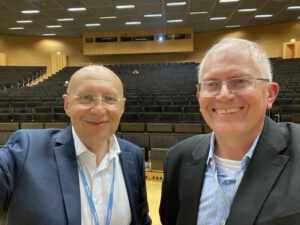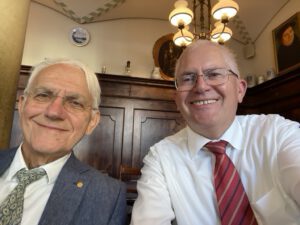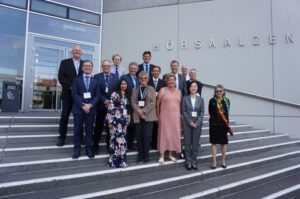Innovations in Optical Engineering: Prof. Jürgen W. Czarske’s 2024 Publications
Dive into the latest advancements in optical engineering and photonics with these compelling 2024 publications:
- Neurophotonics: Tijue Wang and team enhance cancer diagnosis with resolution-boosted multi-core fiber imaging, learning from a digital twin.
- Physics of Fluids: R. Maestri et al. delve into the dynamics of an equilibrium Taylor bubble within a constricted vertical tube.
- Light: Advanced Manufacturing: Julian Lich and colleagues revolutionize 3D incoherent imaging using diffuser endoscopy in a single shot.
- Nature Communications: J. Sun’s team pioneers AI-driven projection tomography, enabling multicore fiber-optic cell rotation.
- Applied Sciences: R Nauber and L Büttner curate a special issue on computational ultrasound imaging, expanding its applications.
- Optics Letters: Jiawei Sun’s group achieves calibration-free quantitative phase imaging in multi-core fiber endoscopes through deep learning.
These publications reflect a year of breakthroughs in computational imaging, AI integration, and novel diagnostic techniques, pushing the boundaries of how we understand and utilize light in medicine and communication. Stay tuned for more groundbreaking research from Prof. Czarske and his team. For detailed insights, refer to the respective journals.
Prof. Jürgen W. Czarske’s 2024 Speaking Engagements: A Glimpse into the Future of Optical Engineering
In 2024, Prof. Czarske and his team are set to illuminate the world of optical engineering with a series of talks at leading conferences. They will showcase their pioneering work in lensless fiber endoscopy, deep neural networks, and quantum technology for groundbreaking applications like cancer cell imaging and brain tumor classification. Their innovative techniques in 3D fluorescence imaging, hologram fabrication, and optogenetic stimulation are pushing the boundaries of medical imaging and diagnostics. These talks, invited by esteemed colleagues and held at prestigious events like SPIE Photonics West and Photonics Europe, promise to offer fascinating insights into the advancements in computational imaging and the use of AI in microscopy. Join the journey into the microscopic world as Prof. Czarske’s team reveals the unseen with cutting-edge optical technologies. For more information on these events, please visit the conference websites or refer to the list below.
- SPIE BiOS, SPIE Photonics West:
- Optical diffraction tomography of rotated cancer cells using lensless fiber endoscopy and deep neural networks, San Francisco, USA, January 28.
- Single-cell investigation of excitation wavefront propagation in in vitro human induced cardiomyocytes, San Francisco, USA, January 27.
- Optogenetic stimulation and fast label-free wide field video microscopy for the investigation of excitation wavefronts in in vitro cardiac tissue, San Francisco, USA, January 28.
- Investigation on impulsive stimulated Brillouin microscopy for high-speed elastography in hydrogel, San Francisco, USA, January 27.
- SPIE Photonics Europe:
- Lensless fiber imaging using deep neural networks and quantum technology, Strasbourg, April 10.
- Correction quality criterion for DOPC guide-stars, Strasbourg, April 10.
- Learning-based optical diffraction tomography for label-free 3D cell imaging, Strasbourg, April 10.
- Characterization and modelling of multimode fibers using holographic transmission matrix measurements, Strasbourg, April 10.
- Virtual staining on unlabeled tissue samples, Strasbourg, April 11.
- Reference-free phase retrieval of multimode fibers enhanced by physics-driven neural network, Strasbourg, April 8.
- Lensless microendoscope for quantitative phase imaging with flexible working distance, Strasbourg, April 8.
- SPIE Photonics West:
- 3D fluorescence imaging with diffuser endoscopy and physics-informed deep learning, San Francisco, USA, January 27.
- Lensless endoscopy via wavefront shaping for fluorescence imaging, San Francisco, USA, January 29.
- Fabrication of holograms on optical fibers via femto-second laser techniques, San Francisco, USA, February 1.
- In vivo brain tumor classification using fiber endoscopy, San Francisco, USA, January 27.
- Deutsche Gesellschaft für Neurochirurgie:
- Autofluorescence based recognition of brain tumors with a convolutional neural network, Göttingen, Germany, June 9.
New ICO Bureau 2024-2027: In South Africa at Nov 24, 2024, during the ICO-26 conference, Prof. Juergen Czarske was elected Vice President of the International Commission for Optics (ICO) for the second time
The ICO is an international organization for optics and photonics based in PALAISEAU Cedex/Paris, France and Miami/Florida, USA, which represents the interests of over 50 member countries and seven associations such as OPTICA (The Optical Society, Washington DC), SPIE (Society of Photographic Instrumentation Engineers, Washington, USA) and Photonics Society of IEEE (Institute of Electrical and Electronics Engineers, New York, USA). Over 50,000 members are thus indirectly represented. The ICO was founded two years after the Second World War in 1947 with the aim of contributing to the progress and dissemination of the interdisciplinary field of optics and its applications at an international level, as well as to promote participants from developing countries and bring them together with top-class researchers and Nobel Prize winners, as was demonstrated in Dresden in September 2022 with the ICO-25, 3 Nobel Prize winners took part, stayed for the concert in the Frauenkirche and came with their wives for dinner and lunch. Participants from 55 countries took part, including from Africa and developing countries in Asia and South America.
Light technology is transforming society with displays, fiber optics for the internet, AI-based optics and advances in medicine. Light technology has the potential to enable early diagnosis of diseases, their prevention or mild therapy.
As ICO Vice President, I intend to share my enthusiasm for exploiting the potential of optics and photonics with young people around the world. Motivation is particularly important in order to reduce the shortage of skilled workers, because advances in lithography and microelectronics such as those at TSMC in Dresden are unthinkable without optics.
Prof. Czarske holds the professorship for measurement and sensor system technology at the Faculty of Electrical Engineering and Information Technology and heads the Biomedical Computational Laser Systems (BIOLAS) competence center. He is a fellow of the Optical Society (OSA), European Optical Society (EOS), Institution of Engineering and Technology (IET), and International Society of Optics and Photonics (SPIE). He has received several awards, including the OPTICA Joseph Fraunhofer Award / Robert M. Burley Prize 2019 and the SPIE Dennis Gabor Award 2024.




